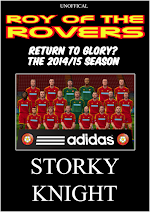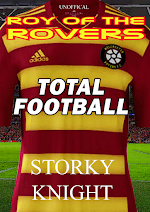From 1965 to the end of the decade, Melchester Rovers made very few changes to their regular outfit. The short sleeve version of the shirt now featured smart red trims that floated above the cuffs. Yellow socks were first choice, but red also worn regularly, notably during the Cup Winners' Cup run of 1966/67.
The shield badge was added permanently to the jerseys at the start of the 1967/68 season having previously only been worn in Cup Finals. The shirts, worn with yellow socks would remain unchanged until 1970, but the different shades of blue shorts, from navy, to royal, to sky, would be worn with numbers also added.
At the end of the 1969/70 season, for a match with Lintown, Rovers first wore the sky blue shorts to avoid the clash with their opponent's royal blue. The colour choice became a short term favourite as Rovers won the FA Cup with a victory over Seaford Athletic at Wembley.
Between 1970 and 1973, Rovers wore brighter shades of yellow and royal blue along with the redder version of the shield badge. The kit would prove lucky with Rovers winning the Cup Winners' Cup (1971), the Double in 1971/72, and the European Cup in 1973!
Something strange then happened, as far as Rovers supporters and players believed! On the first match of the 1973/74 season Melchester Rovers ran out in an ultra modern strip designed by Barrie Tomlinson. A sleek all red strip with a sharp yellow stripe was highlighted by unique numbers on the sleeves. To top of the new look the strip theme continued even onto the socks! The fans were shocked and the players unimpressed as poor form and injuries led them to believe the new strip to be cursed. However, Penny, club secretary and Roy's future wife discovered hidden in the archives, that Rovers had worn a similar shirt in 1907 when they first won the FA Cup. Destiny had it that Rovers would repeat that feat, also adding the League Cup, in a first ever Double Cup Double.
The new strip would last unchanged until 1979/80 even seen as smart enough to be worn to Roy and Penny's wedding as the other first teamers lined the church path fully kitted out.
1979/80 saw a collar added to the shirt and the sleeve numbers disappear. New defender Vic Guthrie would help Rovers to the league title. But the next season would be the worst for the club since the 1920s! Wearing a new v-neck version of the now classic strip, Rovers were relegated!
Another kit first then followed as Rovers found a first sponsor in sportswear brand Gola. A hooped shirt and new lettered badge gave the Second Division Rovers a welcome new look and despite Roy being shot they romped to promotion. After objections from various outsiders, Rovers dropped the sponsorship but continued to wear the now brandless hooped shirts until that shirt too had its off-field moment.
On an end of season tour to Basran, Roy and his Rovers were abducted by rebels during the match. They attempted escape, but fell foul to a suicide bomber. Noel Baxter, Kenny Logan, Steve Naylor, Trevor Cassidy, Neville Jones and Carl Hunt would perish, all wearing their favourite Melchester Rovers kits.
Fittingly, with a major rebuilding process to begin, Rovers began the 1986/87 season with a host of new players and a brand new sponsored kit. This time American sports giants Nike were given the privilege and produced a new look all red outfit with red side panels. The new round black football badge was also debuted. This new kit was worn with three different shirt sponsors, Nike, iconic sticker company Panini and publishers Fleetway. One moment of history was made as Andy MacLaren was signed for a British record fee and he made his debut in the Panini sponsored shirt.
The Nike template lasted until the end of the 1990/91 season, when a competition was launched to design the new Rovers kits. The winning design was a fantastic stripey effort with a sponsor that had rapidly become a favourite with youngsters across the country - SEGA! Rovers fans were also given the chance to choose the new badge from three uninspiring options. An updated version of the black football badge was the pick and would appear on the shirts for two years.
The Japanese brand would sadly only last one season, and the kit didn't quite shine as much with the blue TSB logo.
Next week will be the final part of the complete history of Melchester Rovers kits, covering the period from 1993 to today and also including a host of alternative designs that have been shown over the years.
NOTE: During the 1966/67 season, when shown in colour the socks were always red, but in the same matches the black and white images gave the impression of yellow. Umbro never appeared on the 1991-93 shirts, but did on other items of Rovers kit, training wear and tracksuits.

















0 Comments